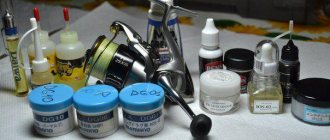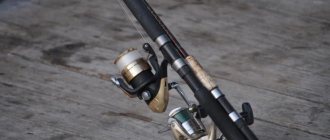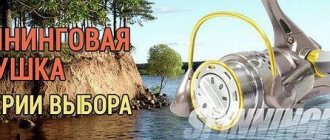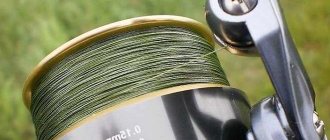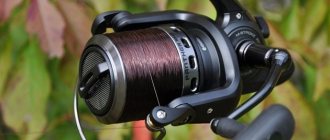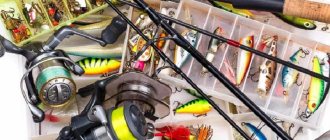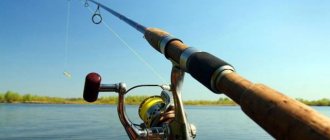What should a newbie pay attention to?
There are several criteria that are closely related to each other. Based on them, you can choose the right coil:
- type and weight of fish;
- rod length and power;
- type of reservoir, casting distance.
Reel reliability is the next criterion. Try to choose a reel from the most famous brand. And if you buy several of them, it is advisable that they be from the same manufacturer if possible. In this case, it will be easier to repair it, find spare parts, or, in extreme cases, combine one of the two.
The third criterion is efficiency . It’s hardly worth purchasing something from the Shimano Stella range that costs $1000-2000 for your first fishing trip. Buy something simpler and practice. If you like it, then buy something more serious. It’s hard to say below what price you shouldn’t go... Probably not below $50 for an inertia engine.
In the store, it is still worth paying attention to some details.
- For example, not very well made inertial coils spontaneously close the bow . It's difficult to check this in a store, but try it anyway. Open the bail and shake the reel sharply several times; if the bail is closed, then this is not your option.
- Pay attention to the smooth ride . There should be no backlash, noise or jamming.
- It's good if the kit includes a spare spool .
Video analysis
We do not recommend using inertial and multiplier reels for beginners. They are too complicated to work with, so they can give negative results during the fishing process. The best choice for a beginner is a spinning reel. It is universal, it can be used for almost any type of fishing. Considering the reasonable cost of spinning reels, we recommend purchasing these particular varieties. Even a child can master working with such a reel in a very short time.
If you are an experienced fisherman, then turn your attention to multiplier models, which are the future. After mastering them, you will experience all the possibilities of spinning.
How to choose an inertial coil
Neva inertial coil
Very often, beginners are told to start with an inertial reel. But I know fishermen who don’t even imagine that such things exist.
And vice versa, some of my friends use exclusively inertia. I have been using both reels for many years.
An inertial spinning reel has several disadvantages:
- does not work well with light bait;
- low gear ratio, you have to work intensively with your hand when fishing or guiding a predator;
- Due to the release of excess fishing line when the bait falls into the water, beards can form.
But there are also advantages:
- impeccable reliability;
- durability;
- high traction;
- cheapness;

Inertial reels have a drum with handles on a holder that is attached to the fishing rod. Additionally, as standard, the reel is equipped with a brake with a ratchet and a brake release button.
The sliding of the drum on the axis depends on how the drum is installed. It could be
- sliding bearing (sleeve - axle), the simplest connection, sliding depends on the ground-in surface, may have play.
- improved plain bearing on cones (sleeve - cone), significantly reduces friction and backlash
- ball bearing (sleeve - bearing) has a better sliding coefficient.
A bearing connection is certainly better, but less practical. If sand gets into the bearing, the movement deteriorates noticeably, and this can lead to system failure.
Drums are:
- plastic
- aluminum
- steel
I won’t even say anything about the first ones, the second ones are light, but, unfortunately, bend, the third ones don’t bend, but are heavy. I would prefer hardened steel .
There are not so many inertial coils produced anymore, but there is still plenty to choose from:
- Stubla - a drum with a diameter of 130 mm is made of aluminum, rotates on two bearings. Suitable for feeder fishing, jigging, vertical trolling, as well as wire fishing, or any type of spinning fishing from a boat or shore. Manufacturer: Ukraine. Price – $8
- Nelma - aluminum drum diameter 114 mm is mounted on bearings. Designed for line fishing, feeder fishing and any fishing from a boat. Has an aerodynamic brake, reverse stopper, axial brake. Manufacturer Russia. Price: $75.
- Neva - unfortunately, it has not been produced for a long time and the plant is closed. There are Neva coils on sale, but they are all Chinese.
Coil size
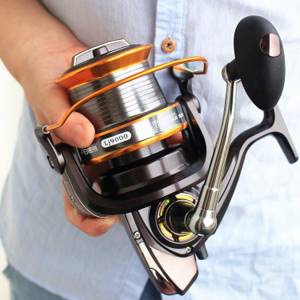
Before choosing a reel, you need to decide on its size. The power of the product and its other indicators depend on this. Special units of measurement in thousands are used to indicate size. The most successful classification is considered to be from Shimano and Daiwa.
You may be interested in: Kosadaka Wobblers
Reels 1000-2500 are designed for light spinning, working with small baits and catching small fish. If you are looking for which reel to choose for spinning with medium or heavy baits, it is worth considering options in sizes 3000-5000. Large sizes are usually not suitable for spinning rods and are used in sea fishing and carp fishing.
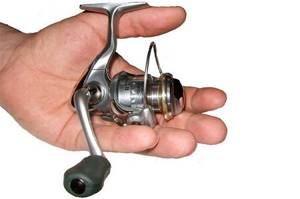
How to choose a spinning reel
Smooth running is the main parameter of a spinning reel. When rotating the reel handle, there should be no noise or vibration. When buying new reels, this parameter is good for everyone. The trouble is that it begins to manifest itself later. Smoothness is lost especially quickly in cheap plastic devices. Therefore, it is better to choose reels with a metal body. They are reliable and durable. When fishing, you should hear the rustling of grass, and not the squealing and crackling of the reel.
Gear ratio
This is a parameter that I would pay attention to if you yourself understand what kind of fish you are hunting. If you find any one, then the reel can be with any gear ratio. If you take this seriously, pay attention to the markings indicated on the reel. Among them you will see something like “Gear Ratio 5.2:1”. This marking indicates that for a full turn of the reel handle, the pin makes 5.2 turns. This is a fairly powerful reel designed for large bottom fish. For catching pike, perch or pike perch, a reel with a lower gear ratio, around 4:1, is better suited.
Friction brake
As a rule, the clutch is located behind the reel, sometimes in front or on both sides. It would be nice to configure it correctly. The friction brake dampens the jerk of large fish during a bite and helps to avoid line breakage.
If the regulator is located on the back of the reel, then when fishing for large prey it can be further adjusted on the go.
To initially adjust the friction brake, you can tie the end of the fishing line to something heavy and, while pulling the rod at 90-120 degrees, set the friction so that it operates at approximately 80% of the load. At 100% the line should break
In fact, for spinning rods three or more meters long, the friction brake is not so important, because the jerk will smooth out the end of the rod. But for short and stiff rods the function is undoubtedly useful.
Spool
A spool is a drum on which the fishing line is stored. It wraps around it and unwinds when casting. The larger it is, the better, but it is advisable that it be metal, especially if you are going to catch a predator with braid and not monofilament.
How to choose a reel for a spinning rod
In order for your fishing to be successful, and for you not to experience difficulties with casting and landing fish, you need to choose the right spinning rod and reel. More precisely, combine the reel with an existing spinning rod.
Spinning reels are divided into classes:
- Class 500. They weigh less than 170 g. They are used on light ultralight spinning rods.
- Class 1000-1500. Used on light and ultralight spinning rods.
- Class 2000. It is universal and can be used on the vast majority of spinning rods.
- Class 3000-4000. Used with powerful feeder type rods.
- Class 4500. Mounted on a very thick and durable fishing rod. Suitable for fishing for very large fish, such as catfish or silver carp.
If you use a lightweight rod, then you should choose a lightweight reel. For example, if the length of the spinning rod is less than 2.5 m, a 500-1500 class reel is best suited for it. If the rod has a length of 2.5-3.5 m, then a reel of class 2500 would be ideal. For a longer rod or if the spinning rod is thick, a reel class of 3000 or more is selected.
Selecting a baitcasting reel
A multiplier reel is essentially a mini winch. This is a powerful unit for landing heavy fish.
The main advantage of a baitcasting reel, besides its power, is that the line does not twist , like a spinning reel. The casting range of a multiplier is approximately two times greater than that of a spinning bait. Accordingly, the price is higher. If you throw further, you pay more.
You should also know that not every rod can support this type of reel, and not everyone will be able to mount it.
Choosing a spinning reel
Choosing a spinning reel is not an easy task, especially for a beginner. It would seem, what difference does it make - well, it turns and turns, why buy a reel that is several times more expensive? If only everything were that simple...
In order to make the right choice, you need to at least study a little about the structure of the reel and what the price of it is made up of.

Spinning reel for pike
Pike, when hungry, are not particularly picky and grab everything that glitters. An excellent example was when my little one, while lowering his toys into the water on the pier, caught a little puppy on them.
You will have to cast often and reel in just as much, so when fishing for pike I would recommend light reels as well as light rods .
From the coils I would recommend:
- Daiwa Sweepfire is inexpensive, under $30, but works great on one bearing. It is better to dilute the factory lubricant immediately.
- Ryobi Tresor - has a good stroke, but play appears over time, however, it has an instant reverse stopper. It will last for several years if you fish on weekends. Price: $50.
- Shimano Elf - has three bearings on the main pair in the reel, which ensure the laying of the braid, weighs a little, has almost no play, but costs a little more - $100.
How to catch pike | Where and when to fish, the choice of gear and bait is certainly a useful article for those who hunt toothy predators.
Reel prices
Here is a list of some quality reels for spinning fishing:
- Daiwa Sweepfire 2500B. It has an IF 5.3:1, only 1 bearing, a spool with a capacity of 0.5 mm/150 m. Cost - 600 rubles.
- Salmo Diamond Baitfeeder 6 30Br. Bearings - 5+1, IF - 5.2:1, weight - 375 g, spool - 0.25 mm/250 m. Cost - 1900 rubles.
- RYOBI Ecusima 1000. Bearings - 4+1, frequency converter - 5.1:1, weight - 262 g. Cost - 2400 rubles.
- Shimano CATANA 3000SRB. IF - 5.2:1, weight - 285 g, 2 bearings, spool - 0.2/220 m. Price - 3250 rub.
- Shimano EXAGE 4000FC. Weight - 320 g, 4 bearings, IF - 5.2:1, spool - 0.3/180 m. Cost - 5600 rubles.
As you can see, you can inexpensively buy reels from the world's leading manufacturers, the quality of whose products cannot be doubted.
Ultralight Club
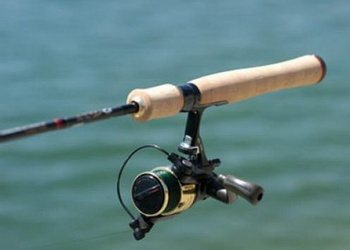
Balachevtsev Maxim
Below we will not talk about choosing a spinning rod or reel per se. Here we will try to talk about how best to choose a rod and reel that will be harmoniously combined. In principle, this has been written about repeatedly in various periodicals, but basically the recommendations boiled down to the following: heavy spinning rod - large reel, light spinning rod - small reel. For a person experienced in fishing, this rule will be understood correctly. An inexperienced fisherman often makes mistakes when buying gear.
What to buy first - a rod or a reel? That is, what should come first? This question can be solved quite easily and the answer is clear. We cast using the elastic properties of the spinning rod blank, we also land the fish using a “stick”, in some cases the retrieving is done mostly with a rod (jigging), and in some cases with a reel (uniform retrieving). Of course, the reel is involved in all stages of spinning fishing: casting, retrieving and retrieving, but its influence is an order of magnitude less significant than the influence of the spinning rod itself. It’s quite easy to check this view of this problem - let’s take two tackles: a Garbolino Spinny rod 2.6 m / 8-15 g with an LMZ reel and a spinning rod for 9 rubles. 30 kopecks (the favorite duralumin tackle of the older generation of spinners) with a Shimano Stella 3000 reel. Now let’s try to throw a spoon (the most common) weighing about 8-10 grams. A “dural” paired with a Shimano will cast no further than ten meters, while a Garbolino, even equipped with a LeMZ, will send such a bait at least twice as far. Due to the “normal” action, a good rod can mitigate the unnecessary unevenness of the retrieve created by a bad reel, but a good reel will in no way help you eliminate the excessive “sausage” or “oakiness” of the rod. Fishing for a “trophy” with a bad reel, of course, is difficult due to the almost complete absence of a friction brake on cheap models (there is a brake, but it is rather decorative), but it is even more difficult due to the poor action of the rod. “Sausage” or “oak” spinning rods simply cannot timely extinguish the high-speed jerks of even pike and perch, not to mention salmon. And so, we decided that the rod was of paramount importance. It is for this that we will go to the store. If this store has a sufficient assortment of reels, then you are in luck. You can “choose socks to match the color of your shoes” right at the counter.
What to save on - on a spinning rod or on a reel? This question is more complex than the previous one. Although spinning has a greater impact on fishing than a reel, the latter, if it is “totally bad,” can greatly ruin the mood when fishing. To solve this problem, I will venture to show a graph of the increase in performance characteristics of spinning rods and reels depending on price. This graph is approximate, it has many deviations, but in most cases it reflects the level of quality of gear relative to its price. When analyzing this graph, your task will be to choose gear (spinning rod and reel) of the same level of performance. “Working qualities” and simply “quality” are different concepts.
If the concept of “quality” is taken away from the “prestige” and “polishedness” of details, then only “working qualities” will remain. It is this concept that I will use in the future when talking about quality. For fishing it will be optimal if both components of the tackle are of the same quality. But there is a pitfall here. Many of us are constantly improving our gear, constantly “buying” new, more advanced models. Having initially 110 USD you can buy a reel for 50 and a “stick” for 60, or you can buy a spinning rod for 90 and a reel for 20. When you move to the next level in equipment, in the first case you will have to change both tackles, in the second case - only the reel. But until you reach this level, you will have to come to terms with the big disadvantages of a cheap reel. It’s up to you to choose, and to a large extent it depends on the “thickness of your wallet.” If we take into account only the ease of using gear on a pond (and this is the most important thing), then the rod and reel should be of the same quality level. And, as you can see from the graph, on average, a reel is always slightly cheaper than a rod. There are a few more points here that are a topic for a separate conversation: heavy trolling (the importance of the reel far exceeds the importance of the rod), ultralight fishing (without a high-quality rod nothing can be done at all). And there are a lot of such moments. But for the average spinning player (pike from 0.5 to 5 kg, pike perch from 0.5 to 3 kg, perch up to 1 kg) all of the above is true. Should the reel “balance” the spinning rod? Definitely no. How often have I seen fishermen in stores who, having placed a small reel on a spinning rod and balancing the assembled spinning rod on their index finger, declared: “No, this reel is a little light. We should have more. There is no balance." The reel is not selected by weight, but by power and speed!
What reel do you need for an ultra-light spinning rod 3 meters long with a cast of up to 5 grams? By hanging a thousand rod (about 250 g) or a five hundred rod (200 g) on it, you will never get any balancing - the end of the rod will always outweigh. So what should you put on a five-thousander on an ultralight? Rave! Ideally, if we could create a coil of foam weighing 10 grams, that would be great! After all, not a single company is trying to increase the weight of the reel; everyone is trying to reduce its weight (spool perforation, porous
metal and other tricks). That is, the smaller/lighter the coil, the better. And for any spinning rod. But here the next factor comes into force - the weight and type of bait, the fish being caught, the fishing conditions. It is clear that there is no point in putting a miniature (light) reel on a powerful salmon “stick” with 40-80 g of dough. The main indicator of a reel, which depends on its size, is power, that is, the ratio of the force applied to the handle to the force on the line guide. Plus, the power of the coil is determined by its “hard teeth,” that is, the material and size of the gear teeth. If we catch large fish or if the resistance of the bait when retrieving is high, then we need to choose a powerful reel. If we catch perch or trout with small spinners, then the power of the reel can be neglected in favor of reducing its size/weight. Increasing power while maintaining size/weight allows for a lighter overall tackle, which is always a good thing. The speed of the coil, that is, the gear ratio, can be neglected in most cases. Personally, I don’t see a fundamental difference between speed 1:5 and 1:6. Another thing is special fishing, for example, asp fishing, where the reeling speed has a significant impact. We will not analyze the design of the coils and their characteristics in more detail - this is also a topic for a separate discussion.
The main conclusion on this issue is this: the reel is selected not for spinning, but for fishing. Just like the spinning rod itself. And if you have correctly determined which spinning rod and which reel are needed for certain conditions, then have no doubt – they will be harmoniously combined. For those who found what I said above too confusing, here is a table showing the parameters of the rod and the corresponding reel. The “reel number” column indicates the size of the Shimano reel. In general, the number/size of the coil can also be indicated by the first digit of a three-digit number or the penultimate digit of a four or three-digit number. There are several more options. To avoid confusion, there is another parameter indicating the size of the reel - this is the diameter of the spool skirt. Therefore, in the table next to the Shimano number, I will give the approximate diameter of the spool skirt (in mm), which can be easily measured with a regular ruler in your hands.
spinning rod length spinning rod test reel number 180 cm up to 5 g 500(38-40) 5-15 g 500(38-40)-1000(40-42) 20-40 g 2000(42-44)-3000(46-48 ) 210 cm up to 5 g 500(38-40)-1000(40-42) 5-15 g 1000(40-42) 240 cm up to 5 g 1000(40-42) 5-15 g 1000(40-42) 10-30g 1000(40-42)-2500(44-46) 270 cm up to 5 g 1000(40-42) 5-15 g 1000(40-42) 10-30 g 2000(42-44) 30-50 g 2500(44-46)-4000(48-51) 300 cm up to 10 g 1000(40-42) 5-25 g 1000(40-42)-2000(42-44) 20-40 g 2500(44- 46)-3000(46-48) 40-80 g 3000(46-48)-4000(48-51)
Reel and “its holder”. There are four main types of reel seats: classic (rear), front, remote and sliding. A classic reel seat is a threaded insert in the rod handle, in the front part of which there is a stop (groove, recess) for the front part of the reel leg, and at the back there is a sliding band and a clamping nut (one or two). Frontal – recess under the back of the reel leg; The front part of the spinning rod handle has a recess for the reel leg and is mounted on a thread. By rotating the front part of the handle we clamp the reel. External - metal bracket - in front, recess for the leg - in the back, a snap-on stop is installed. Sliding – two plastic rings that move freely on the handle of the spinning rod. The rings have recesses for the reel legs. So which reel seat should you choose?
Since an external reel seat is not currently used on spinning rods, the choice comes down to three types. The answer to this question is quite simple. We choose a spinning rod, not a reel seat, and it doesn’t matter which type will be installed on the “stick” that suits us. But if we have to make a choice among three identical spinning rods with different types of reel seats, then we need to be guided by the following advantages and disadvantages of the types of reel seats. Classic: “+” – the most reliable, does not break, holds the reel firmly. “-” - in cheap models, the rear nut is periodically unscrewed during the casting process and needs to be tightened. The reel is installed in one specific place on the handle. Most of the handle is not covered with cork, which is undesirable in cold weather. Front: “+” – a larger part of the handle is covered with cork than a classic reel seat. Holds the reel quite firmly. “-” – The coil is installed in one specific place on the handle. Some models of even expensive fishing rods often break (the cork on the clamping part crumbles due to the loose fit of the cork to the spinning rod blank). Sliding: “+” – the reel can be installed anywhere in the handle (“under your arm”), which ensures maximum fishing convenience. The coating is maximally closed with cork - it does not break; “-” – slightly less strength to hold the coil (sometimes you have to use a small bandage made of insulating tape).
Which reel seat to choose is up to you, but I will repeat once again - we are choosing a spinning rod, and the type of reel seat is not so important.
The best manufacturers of spinning reels - which company to choose
In short, you should pay attention to the products of companies that have proven themselves in the fishing tackle market. As a rule, these are Japanese and English companies, but there are some good models from Taiwan and Korea.
Among the best manufacturers of spinning reels are:
1. Shimano
2. Daiwa
3. Ryobi
4. Kosadaka
5. Abu Garcia
6. Banax
A more detailed review of reels from different manufacturers can be found in the review article of the best spinning reels.
Recommendations: 14 Best Fishing Rods
19 Best Fishing Lures
20 Best Fishing Lines


